Predictive Machine Learning Model to Assess the Adsorption Efficiency of Biochar-Heavy Metals for Effective Remediation of Soil–Plant Environment
Abstract
1. Introduction
2. Material and Methods
2.1. Data Collection and Modeling Methods
2.2. Data Analyzing
2.3. Linear Regression (LR)
2.4. Partial Least Squares (PLS)
2.5. Support Vector Regression (SVR)
2.6. Random Forest (RF)
2.7. Models’ Predictability and Generalizability
3. Results and Discussion
3.1. Comparison of Biochar, Soil, and Crops in the Pearson Correlation Matrix
3.2. Statistical Analysis of the Prediction Models
3.3. Potential Controls of Soil, Biochar, and Corp Characteristics for HMs Immobilization
3.4. RF Model Development for Predicting HMs Bioavailability with Biochar Application
4. Conclusions
Supplementary Materials
Author Contributions
Funding
Institutional Review Board Statement
Informed Consent Statement
Data Availability Statement
Acknowledgments
Conflicts of Interest
References
- Bolan, N.S.; Makino, T.; Kunhikrishnan, A.; Kim, P.-J.; Ishikawa, S.; Murakami, M.; Naidu, R.; Kirkham, M.B. Chapter Four—Cadmium Contamination and Its Risk Management in Rice Ecosystems. In Advances in Agronomy; Sparks, D.L., Ed.; Advances in Agronomy; Academic Press: Cambridge, MA, USA, 2013; Volume 119, pp. 183–273. [Google Scholar]
- Rai, P.K.; Lee, S.S.; Zhang, M.; Tsang, Y.F.; Kim, K.-H. Heavy Metals in Food Crops: Health Risks, Fate, Mechanisms, and Management. Environ. Int. 2019, 125, 365–385. [Google Scholar] [CrossRef] [PubMed]
- Li, B.; Yang, L.; Wang, C.; Zhang, Q.; Liu, Q.; Li, Y.; Xiao, R. Adsorption of Cd(II) from Aqueous Solutions by Rape Straw Biochar Derived from Different Modification Processes. Chemosphere 2017, 175, 332–340. [Google Scholar] [CrossRef] [PubMed]
- Beesley, L.; Moreno-Jiménez, E.; Gomez-Eyles, J.L.; Harris, E.; Robinson, B.; Sizmur, T. A Review of Biochars’ Potential Role in the Remediation, Revegetation and Restoration of Contaminated Soils. Environ. Pollut. 2011, 159, 3269–3282. [Google Scholar] [CrossRef] [PubMed]
- Gong, Y.; Zhao, D.; Wang, Q. An Overview of Field-Scale Studies on Remediation of Soil Contaminated with Heavy Metals and Metalloids: Technical Progress over the Last Decade. Water Res. 2018, 147, 440–460. [Google Scholar] [CrossRef] [PubMed]
- Devi, R.V.; Nair, V.V.; Sathyamoorthy, P.; Doble, M. Mixture of CaCO3 Polymorphs Serves as Best Adsorbent of Heavy Metals in Quadruple System. J. Hazard. Toxic Radioact. Waste 2022, 26, 04021043. [Google Scholar] [CrossRef]
- Pan, S.; Shen, J.; Deng, Z.; Zhang, X.; Pan, B. Metastable Nano-Zirconium Phosphate inside Gel-Type Ion Exchanger for Enhanced Removal of Heavy Metals. J. Hazard. Mater. 2022, 423, 127158. [Google Scholar] [CrossRef]
- Gámiz, B.; Velarde, P.; Spokas, K.A.; Hermosín, M.C.; Cox, L. Biochar Soil Additions Affect Herbicide Fate: Importance of Application Timing and Feedstock Species. J. Agric. Food Chem. 2017, 65, 3109–3117. [Google Scholar] [CrossRef]
- Patel, H.K.; Joshi, M.P.; Kalaria, R.K. Biochar: A Futuristic Tool to Remove Heavy Metals from Contaminated Soils. In Biochar and Its Application in Bioremediation; Thapar Kapoor, R., Treichel, H., Shah, M.P., Eds.; Springer Nature: Singapore, 2021; pp. 231–258. ISBN 9789811640599. [Google Scholar]
- Qian, K.; Kumar, A.; Zhang, H.; Bellmer, D.; Huhnke, R. Recent Advances in Utilization of Biochar. Renew. Sustain. Energy Rev. 2015, 42, 1055–1064. [Google Scholar] [CrossRef]
- Liu, Y.; Chen, J. Effect of Ageing on Biochar Properties and Pollutant Management. Chemosphere 2022, 292, 133427. [Google Scholar] [CrossRef]
- Guo, X.; Wei, Z.; Penn, C.J.; Xu, T.; Wu, Q. Effect of Soil Washing and Liming on Bioavailability of Heavy Metals in Acid Contaminated Soil. Soil Sci. Soc. Am. J. 2013, 77, 432–441. [Google Scholar] [CrossRef]
- Liu, L.; Li, W.; Song, W.; Guo, M. Remediation Techniques for Heavy Metal-Contaminated Soils: Principles and Applicability. Sci. Total Environ. 2018, 633, 206–219. [Google Scholar] [CrossRef]
- Mujtaba Munir, M.A.; Yousaf, B.; Ali, M.U.; Dan, C.; Abbas, Q.; Arif, M.; Yang, X. In Situ Synthesis of Micro-Plastics Embedded Sewage-Sludge Co-Pyrolyzed Biochar: Implications for the Remediation of Cr and Pb Availability and Enzymatic Activities from the Contaminated Soil. J. Clean. Prod. 2021, 302, 127005. [Google Scholar] [CrossRef]
- Hamid, Y.; Tang, L.; Hussain, B.; Usman, M.; Liu, L.; Sher, A.; Yang, X. Adsorption of Cd and Pb in Contaminated Gleysol by Composite Treatment of Sepiolite, Organic Manure and Lime in Field and Batch Experiments. Ecotoxicol. Environ. Saf. 2020, 196, 110539. [Google Scholar] [CrossRef] [PubMed]
- Yousaf, B.; Liu, G.; Wang, R.; Imtiaz, M.; Zia-ur-Rehman, M.; Munir, M.A.M.; Niu, Z. Bioavailability Evaluation, Uptake of Heavy Metals and Potential Health Risks via Dietary Exposure in Urban-Industrial Areas. Environ. Sci. Pollut. Res. 2016, 23, 22443–22453. [Google Scholar] [CrossRef]
- Yang, X.; Liu, J.; McGrouther, K.; Huang, H.; Lu, K.; Guo, X.; He, L.; Lin, X.; Che, L.; Ye, Z.; et al. Effect of Biochar on the Extractability of Heavy Metals (Cd, Cu, Pb, and Zn) and Enzyme Activity in Soil. Environ. Sci. Pollut. Res. 2016, 23, 974–984. [Google Scholar] [CrossRef] [PubMed]
- Dutta, S.; de Luis, R.F.; Goscianska, J.; Demessence, A.; Ettlinger, R.; Wuttke, S. Metal–Organic Frameworks for Water Desalination. Adv. Funct. Mater. 2023, 2304790. [Google Scholar] [CrossRef]
- Zhu, X.; Li, Y.; Wang, X. Machine Learning Prediction of Biochar Yield and Carbon Contents in Biochar Based on Biomass Characteristics and Pyrolysis Conditions. Bioresour. Technol. 2019, 288, 121527. [Google Scholar] [CrossRef]
- Wu, G.; Kechavarzi, C.; Li, X.; Wu, S.; Pollard, S.J.T.; Sui, H.; Coulon, F. Machine Learning Models for Predicting PAHs Bioavailability in Compost Amended Soils. Chem. Eng. J. 2013, 223, 747–754. [Google Scholar] [CrossRef]
- Pukalchik, M.A.; Katrutsa, A.M.; Shadrin, D.; Terekhova, V.A.; Oseledets, I.V. Machine Learning Methods for Estimation the Indicators of Phosphogypsum Influence in Soil. J. Soils Sediments 2019, 19, 2265–2276. [Google Scholar] [CrossRef]
- Padarian, J.; Minasny, B.; McBratney, A.B. Machine Learning and Soil Sciences: A Review Aided by Machine Learning Tools. Soil 2020, 6, 35–52. [Google Scholar] [CrossRef]
- Khan, K.Y.; Ali, B.; Cui, X.; Feng, Y.; Stoffella, P.J.; Pan, F.; Tang, L.; Yang, X. Effect of Biochar Amendment on Bioavailability and Accumulation of Cadmium and Trace Elements in Brassica chinensis L. (Chinese Cabbage). JAS 2016, 8, 23. [Google Scholar] [CrossRef]
- Ali, A.; Guo, D.; Arockiam Jeyasundar, P.G.S.; Li, Y.; Xiao, R.; Du, J.; Li, R.; Zhang, Z. Application of Wood Biochar in Polluted Soils Stabilized the Toxic Metals and Enhanced Wheat (Triticum aestivum) Growth and Soil Enzymatic Activity. Ecotoxicol. Environ. Saf. 2019, 184, 109635. [Google Scholar] [CrossRef]
- Lu, K.; Yang, X.; Shen, J.; Robinson, B.; Huang, H.; Liu, D.; Bolan, N.; Pei, J.; Wang, H. Effect of Bamboo and Rice Straw Biochars on the Bioavailability of Cd, Cu, Pb and Zn to Sedum Plumbizincicola. Agric. Ecosyst. Environ. 2014, 191, 124–132. [Google Scholar] [CrossRef]
- Kiran, Y.K.; Barkat, A.; Cui, X.; Feng, Y.; Pan, F.; Tang, L.; Yang, X. Cow Manure and Cow Manure-Derived Biochar Application as a Soil Amendment for Reducing Cadmium Availability and Accumulation by Brassica chinensis L. in Acidic Red Soil. J. Integr. Agric. 2017, 16, 725–734. [Google Scholar] [CrossRef]
- Bashir, S.; Hussain, Q.; Shaaban, M.; Hu, H. Efficiency and Surface Characterization of Different Plant Derived Biochar for Cadmium (Cd) Mobility, Bioaccessibility and Bioavailability to Chinese Cabbage in Highly Contaminated Soil. Chemosphere 2018, 211, 632–639. [Google Scholar] [CrossRef]
- Brennan, A.; Moreno Jiménez, E.; Alburquerque, J.A.; Knapp, C.W.; Switzer, C. Effects of Biochar and Activated Carbon Amendment on Maize Growth and the Uptake and Measured Availability of Polycyclic Aromatic Hydrocarbons (PAHs) and Potentially Toxic Elements (PTEs). Environ. Pollut. 2014, 193, 79–87. [Google Scholar] [CrossRef]
- Derakhshan Nejad, Z.; Rezania, S.; Jung, M.C.; Al-Ghamdi, A.A.; Mustafa, A.E.-Z.M.A.; Elshikh, M.S. Effects of Fine Fractions of Soil Organic, Semi-Organic, and Inorganic Amendments on the Mitigation of Heavy Metal(Loid)s Leaching and Bioavailability in a Post-Mining Area. Chemosphere 2021, 271, 129538. [Google Scholar] [CrossRef] [PubMed]
- Houben, D.; Evrard, L.; Sonnet, P. Beneficial Effects of Biochar Application to Contaminated Soils on the Bioavailability of Cd, Pb and Zn and the Biomass Production of Rapeseed (Brassica napus L.). Biomass Bioenergy 2013, 57, 196–204. [Google Scholar] [CrossRef]
- Almaroai, Y.A.; Usman, A.R.A.; Ahmad, M.; Moon, D.H.; Cho, J.-S.; Joo, Y.K.; Jeon, C.; Lee, S.S.; Ok, Y.S. Effects of Biochar, Cow Bone, and Eggshell on Pb Availability to Maize in Contaminated Soil Irrigated with Saline Water. Environ. Earth Sci. 2014, 71, 1289–1296. [Google Scholar] [CrossRef]
- Zhang, Z.; Solaiman, Z.M.; Meney, K.; Murphy, D.V.; Rengel, Z. Biochars Immobilize Soil Cadmium, but Do Not Improve Growth of Emergent Wetland Species Juncus Subsecundus in Cadmium-Contaminated Soil. J. Soils Sediments 2013, 13, 140–151. [Google Scholar] [CrossRef]
- Brennan, A.; Jiménez, E.M.; Puschenreiter, M.; Alburquerque, J.A.; Switzer, C. Effects of Biochar Amendment on Root Traits and Contaminant Availability of Maize Plants in a Copper and Arsenic Impacted Soil. Plant Soil 2014, 379, 351–360. [Google Scholar] [CrossRef]
- Salam, A.; Bashir, S.; Khan, I.; Hu, H. Two Years Impacts of Rapeseed Residue and Rice Straw Biochar on Pb and Cu Immobilization and Revegetation of Naturally Co-Contaminated Soil. Appl. Geochem. 2019, 105, 97–104. [Google Scholar] [CrossRef]
- Salam, A.; Bashir, S.; Khan, I.; Hussain, Q.; Gao, R.; Hu, H. Biochar Induced Pb and Cu Immobilization, Phytoavailability Attenuation in Chinese Cabbage, and Improved Biochemical Properties in Naturally Co-Contaminated Soil. J. Soils Sediments 2019, 19, 2381–2392. [Google Scholar] [CrossRef]
- Zhang, R.-H.; Li, Z.-G.; Liu, X.-D.; Wang, B.; Zhou, G.-L.; Huang, X.-X.; Lin, C.-F.; Wang, A.; Brooks, M. Immobilization and Bioavailability of Heavy Metals in Greenhouse Soils Amended with Rice Straw-Derived Biochar. Ecol. Eng. 2017, 98, 183–188. [Google Scholar] [CrossRef]
- Kamran, M.; Malik, Z.; Parveen, A.; Zong, Y.; Abbasi, G.H.; Rafiq, M.T.; Shaaban, M.; Mustafa, A.; Bashir, S.; Rafay, M.; et al. Biochar Alleviates Cd Phytotoxicity by Minimizing Bioavailability and Oxidative Stress in Pak Choi (Brassica chinensis L.) Cultivated in Cd-Polluted Soil. J. Environ. Manag. 2019, 250, 109500. [Google Scholar] [CrossRef] [PubMed]
- Li, H.; Xu, H.; Zhou, S.; Yu, Y.; Li, H.; Zhou, C.; Chen, Y.; Li, Y.; Wang, M.; Wang, G. Distribution and Transformation of Lead in Rice Plants Grown in Contaminated Soil Amended with Biochar and Lime. Ecotoxicol. Environ. Saf. 2018, 165, 589–596. [Google Scholar] [CrossRef]
- Abbas, T.; Rizwan, M.; Ali, S.; Zia-ur-Rehman, M.; Farooq Qayyum, M.; Abbas, F.; Hannan, F.; Rinklebe, J.; Sik Ok, Y. Effect of Biochar on Cadmium Bioavailability and Uptake in Wheat (Triticum aestivum L.) Grown in a Soil with Aged Contamination. Ecotoxicol. Environ. Saf. 2017, 140, 37–47. [Google Scholar] [CrossRef]
- Lu, K.; Yang, X.; Gielen, G.; Bolan, N.; Ok, Y.S.; Niazi, N.K.; Xu, S.; Yuan, G.; Chen, X.; Zhang, X.; et al. Effect of Bamboo and Rice Straw Biochars on the Mobility and Redistribution of Heavy Metals (Cd, Cu, Pb and Zn) in Contaminated Soil. J. Environ. Manag. 2017, 186, 285–292. [Google Scholar] [CrossRef]
- Irfan, M.; Ishaq, F.; Muhammad, D.; Khan, M.J.; Mian, I.A.; Dawar, K.M.; Muhammad, A.; Ahmad, M.; Anwar, S.; Ali, S.; et al. Effect of Wheat Straw Derived Biochar on the Bioavailability of Pb, Cd and Cr Using Maize as Test Crop. J. Saudi Chem. Soc. 2021, 25, 101232. [Google Scholar] [CrossRef]
- Jing, F.; Chen, C.; Chen, X.; Liu, W.; Wen, X.; Hu, S.; Yang, Z.; Guo, B.; Xu, Y.; Yu, Q. Effects of Wheat Straw Derived Biochar on Cadmium Availability in a Paddy Soil and Its Accumulation in Rice. Environ. Pollut. 2020, 257, 113592. [Google Scholar] [CrossRef]
- Salam, A.; Bashir, S.; Khan, I.; Shahid Rizwan, M.; Afzal Chhajro, M.; Feng, X.; Zhu, J.; Hu, H. Biochars Immobilize Lead and Copper in Naturally Contaminated Soil. Environ. Eng. Sci. 2018, 35, 1349–1360. [Google Scholar] [CrossRef]
- Cass, J.M. Introduction to Linear Regression Analysis. J. R. Stat. Soc. Ser. C (Appl. Stat.) 1983, 32, 94–95. [Google Scholar] [CrossRef]
- Geladi, P.; Kowalski, B.R. Partial Least-Squares Regression: A Tutorial. Anal. Chim. Acta 1986, 185, 1–17. [Google Scholar] [CrossRef]
- Smola, A.J.; Schölkopf, B. A Tutorial on Support Vector Regression. Stat. Comput. 2004, 14, 199–222. [Google Scholar] [CrossRef]
- Breiman, L. Random Forests. Mach. Learn. 2001, 45, 5–32. [Google Scholar] [CrossRef]
- Petelina, E.; Klyashtorin, A.; Yankovich, T. Field Trials on Use of Biochar versus Peat for Land Reclamation Purposes. Available online: https://open.library.ubc.ca/soa/cIRcle/collections/59367/items/1.0042682 (accessed on 14 August 2023).
- Safaei Khorram, M.; Zhang, Q.; Lin, D.; Zheng, Y.; Fang, H.; Yu, Y. Biochar: A Review of Its Impact on Pesticide Behavior in Soil Environments and Its Potential Applications. J. Environ. Sci. 2016, 44, 269–279. [Google Scholar] [CrossRef]
- Wang, C.-C.; Zhang, Q.-C.; Kang, S.-G.; Li, M.-Y.; Zhang, M.-Y.; Xu, W.-M.; Xiang, P.; Ma, L.Q. Heavy Metal(Loid)s in Agricultural Soil from Main Grain Production Regions of China: Bioaccessibility and Health Risks to Humans. Sci. Total Environ. 2023, 858, 159819. [Google Scholar] [CrossRef]
- Shi, R.; Li, J.; Ni, N.; Xu, R. Understanding the Biochar’s Role in Ameliorating Soil Acidity. J. Integr. Agric. 2019, 18, 1508–1517. [Google Scholar] [CrossRef]
- Li, H.; Dong, X.; da Silva, E.B.; de Oliveira, L.M.; Chen, Y.; Ma, L.Q. Mechanisms of Metal Sorption by Biochars: Biochar Characteristics and Modifications. Chemosphere 2017, 178, 466–478. [Google Scholar] [CrossRef]
- Zhu, X.; Wang, X.; Ok, Y.S. The Application of Machine Learning Methods for Prediction of Metal Sorption onto Biochars. J. Hazard. Mater. 2019, 378, 120727. [Google Scholar] [CrossRef]
- Xu, Y.; Liang, X.; Xu, Y.; Qin, X.; Huang, Q.; Wang, L.; Sun, Y. Remediation of Heavy Metal-Polluted Agricultural Soils Using Clay Minerals: A Review. Pedosphere 2017, 27, 193–204. [Google Scholar] [CrossRef]
- Zhao, M.; Dai, Y.; Zhang, M.; Feng, C.; Qin, B.; Zhang, W.; Zhao, N.; Li, Y.; Ni, Z.; Xu, Z.; et al. Mechanisms of Pb and/or Zn Adsorption by Different Biochars: Biochar Characteristics, Stability, and Binding Energies. Sci. Total Environ. 2020, 717, 136894. [Google Scholar] [CrossRef] [PubMed]
- Chen, Z.; Zhang, J.; Huang, L.; Yuan, Z.; Li, Z.; Liu, M. Removal of Cd and Pb with Biochar Made from Dairy Manure at Low Temperature. J. Integr. Agric. 2019, 18, 201–210. [Google Scholar] [CrossRef]
- El Hanandeh, A.; Mahdi, Z.; Imtiaz, M.S. Modelling of the Adsorption of Pb, Cu and Ni Ions from Single and Multi-Component Aqueous Solutions by Date Seed Derived Biochar: Comparison of Six Machine Learning Approaches. Environ. Res. 2021, 192, 110338. [Google Scholar] [CrossRef] [PubMed]
- Xu, R.; Zhao, A. Effect of Biochars on Adsorption of Cu(II), Pb(II) and Cd(II) by Three Variable Charge Soils from Southern China. Environ. Sci. Pollut. Res. 2013, 20, 8491–8501. [Google Scholar] [CrossRef] [PubMed]
- Zhao, Z.; Zhou, W. Insight into Interaction between Biochar and Soil Minerals in Changing Biochar Properties and Adsorption Capacities for Sulfamethoxazole. Environ. Pollut. 2019, 245, 208–217. [Google Scholar] [CrossRef] [PubMed]
- Ramola, S.; Belwal, T.; Li, C.J.; Wang, Y.Y.; Lu, H.H.; Yang, S.M.; Zhou, C.H. Improved Lead Removal from Aqueous Solution Using Novel Porous Bentonite—And Calcite-Biochar Composite. Sci. Total Environ. 2020, 709, 136171. [Google Scholar] [CrossRef] [PubMed]
- Jing, Y.; Cao, Y.; Yang, Q.; Wang, X. Removal of Cd(II) from Aqueous Solution by Clay-Biochar Composite Prepared from Alternanthera Philoxeroides and Bentonite. BioResources 2020, 15, 598–615. [Google Scholar] [CrossRef]
- Zhang, M.; Shan, S.; Chen, Y.; Wang, F.; Yang, D.; Ren, J.; Lu, H.; Ping, L.; Chai, Y. Biochar Reduces Cadmium Accumulation in Rice Grains in a Tungsten Mining Area-Field Experiment: Effects of Biochar Type and Dosage, Rice Variety, and Pollution Level. Environ. Geochem. Health 2019, 41, 43–52. [Google Scholar] [CrossRef]
- Rafique, M.I.; Usman, A.R.A.; Ahmad, M.; Sallam, A.; Al-Wabel, M.I. In Situ Immobilization of Cr and Its Availability to Maize Plants in Tannery Waste–Contaminated Soil: Effects of Biochar Feedstock and Pyrolysis Temperature. J. Soils Sediments 2020, 20, 330–339. [Google Scholar] [CrossRef]
- O’Connor, D.; Peng, T.; Zhang, J.; Tsang, D.C.W.; Alessi, D.S.; Shen, Z.; Bolan, N.S.; Hou, D. Biochar Application for the Remediation of Heavy Metal Polluted Land: A Review of in Situ Field Trials. Sci. Total Environ. 2018, 619–620, 815–826. [Google Scholar] [CrossRef] [PubMed]
- Gul, S.; Whalen, J.K.; Thomas, B.W.; Sachdeva, V.; Deng, H. Physico-Chemical Properties and Microbial Responses in Biochar-Amended Soils: Mechanisms and Future Directions. Agric. Ecosyst. Environ. 2015, 206, 46–59. [Google Scholar] [CrossRef]
- Hu, B.; Xue, J.; Zhou, Y.; Shao, S.; Fu, Z.; Li, Y.; Chen, S.; Qi, L.; Shi, Z. Modelling Bioaccumulation of Heavy Metals in Soil-Crop Ecosystems and Identifying Its Controlling Factors Using Machine Learning. Environ. Pollut. 2020, 262, 114308. [Google Scholar] [CrossRef] [PubMed]
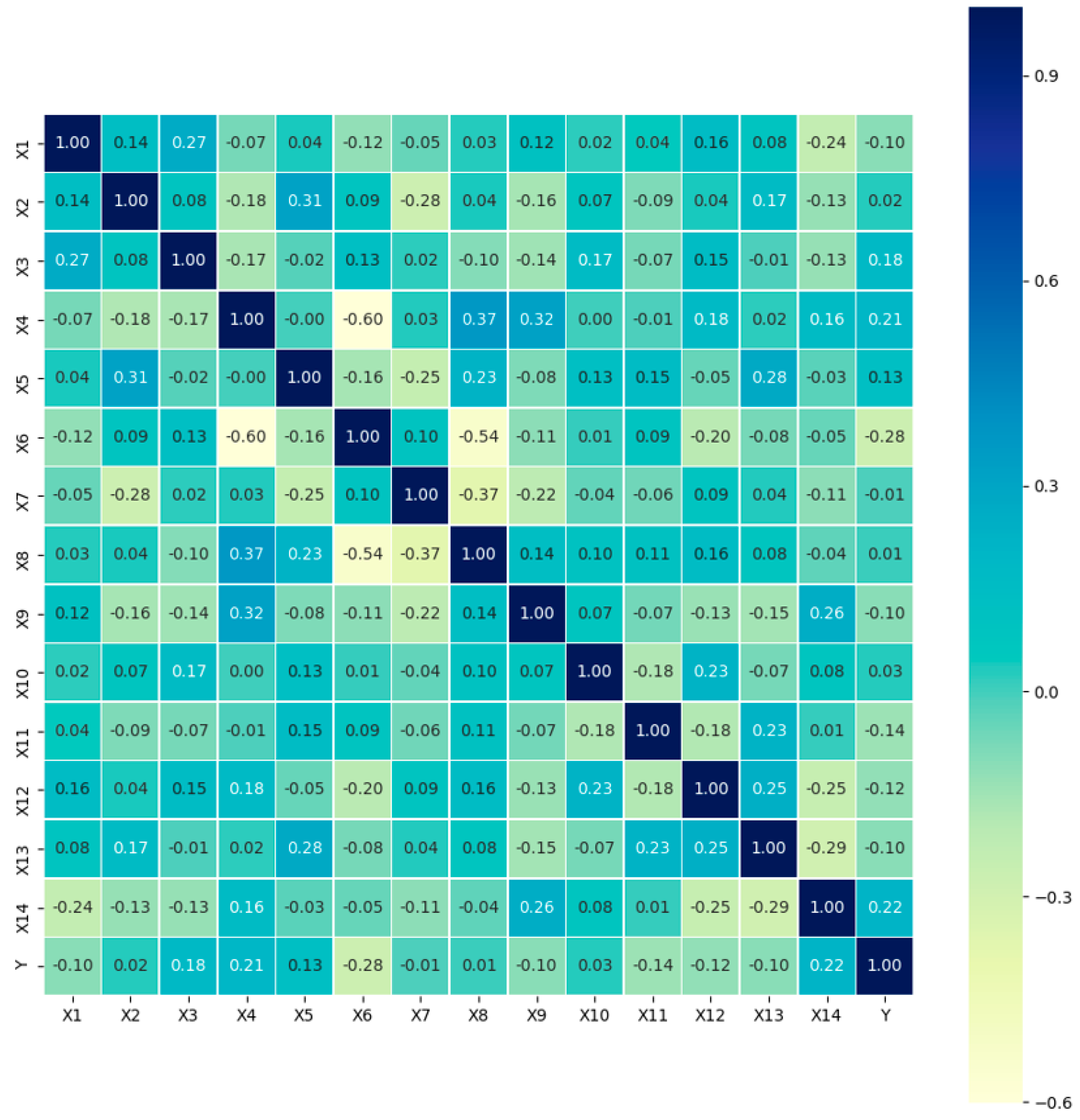
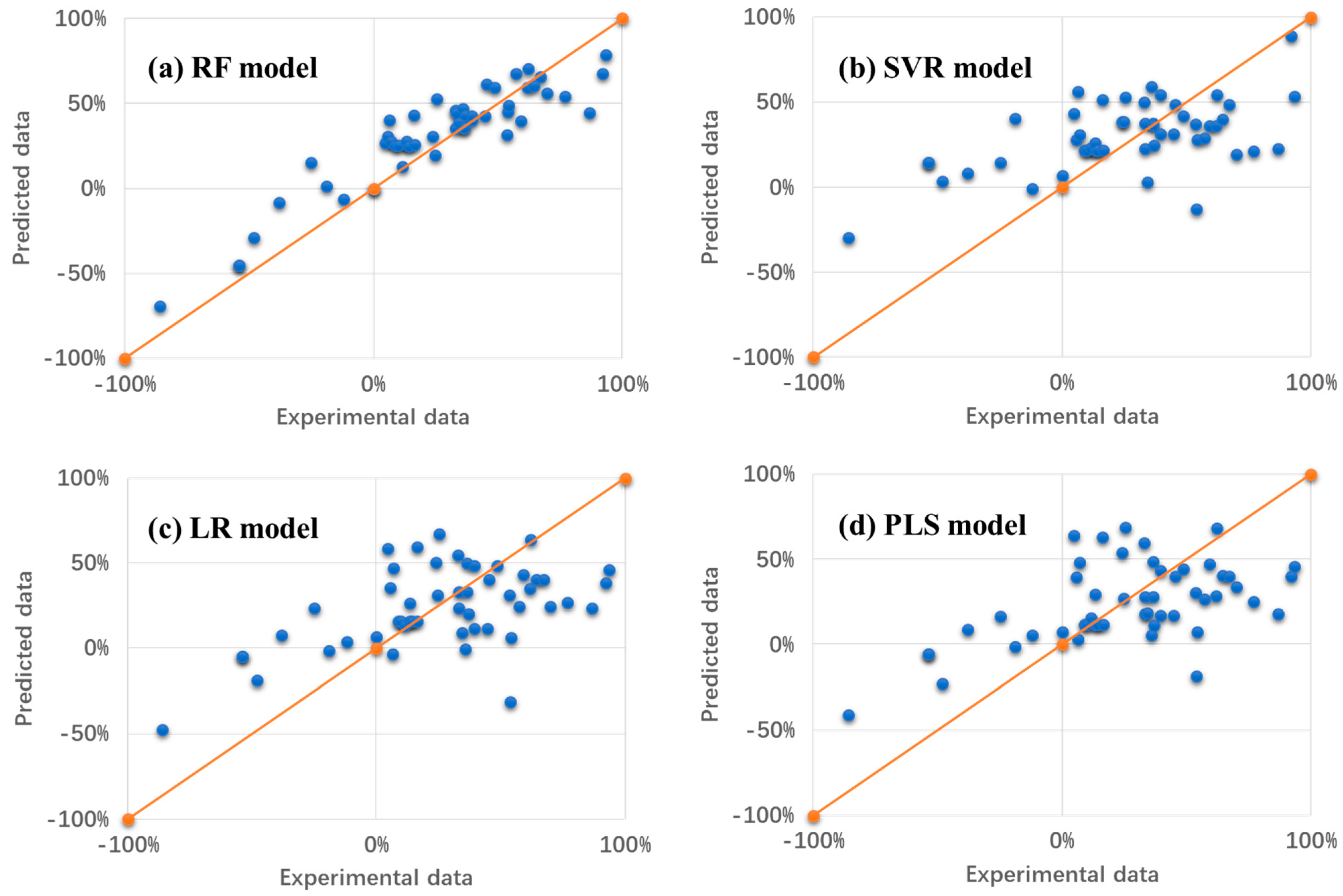
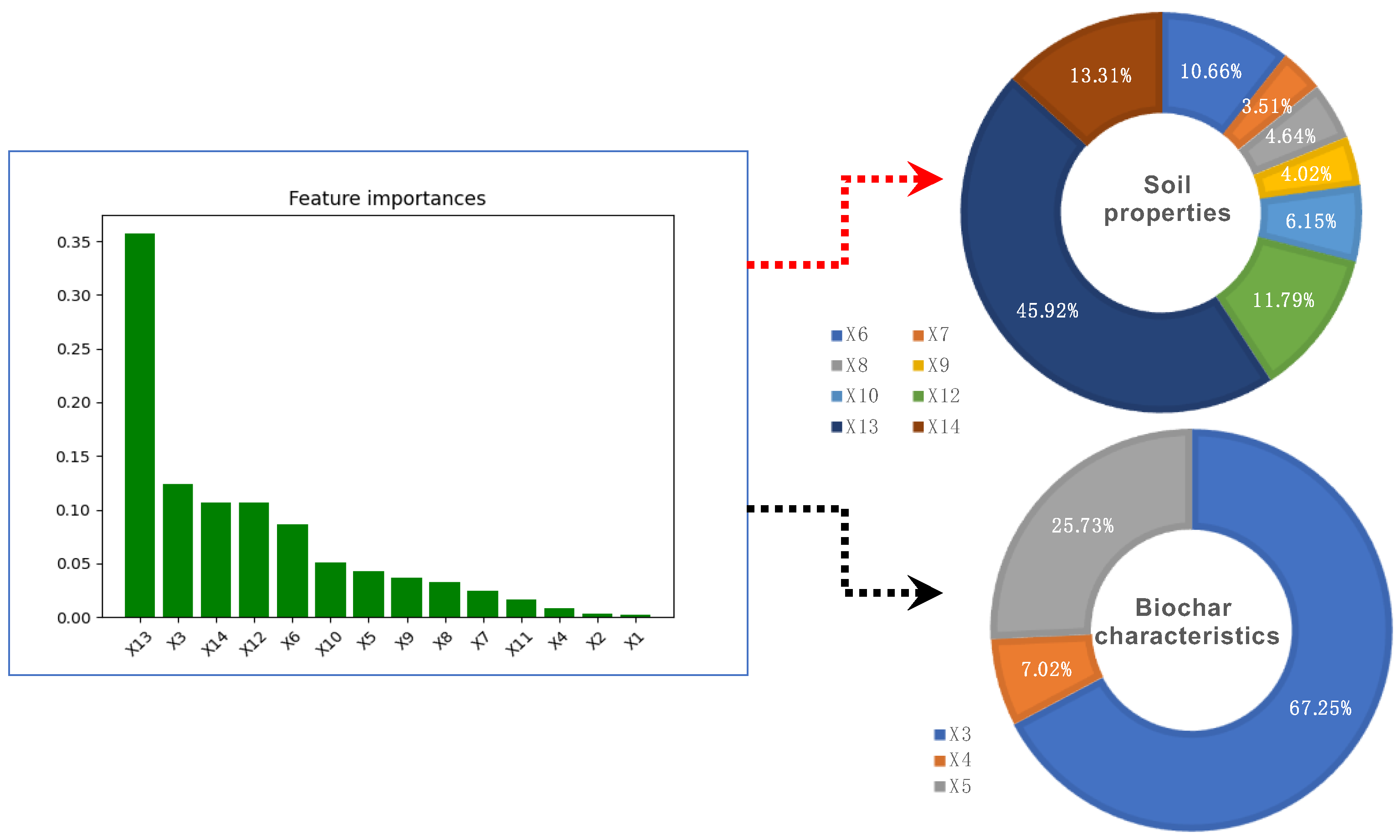
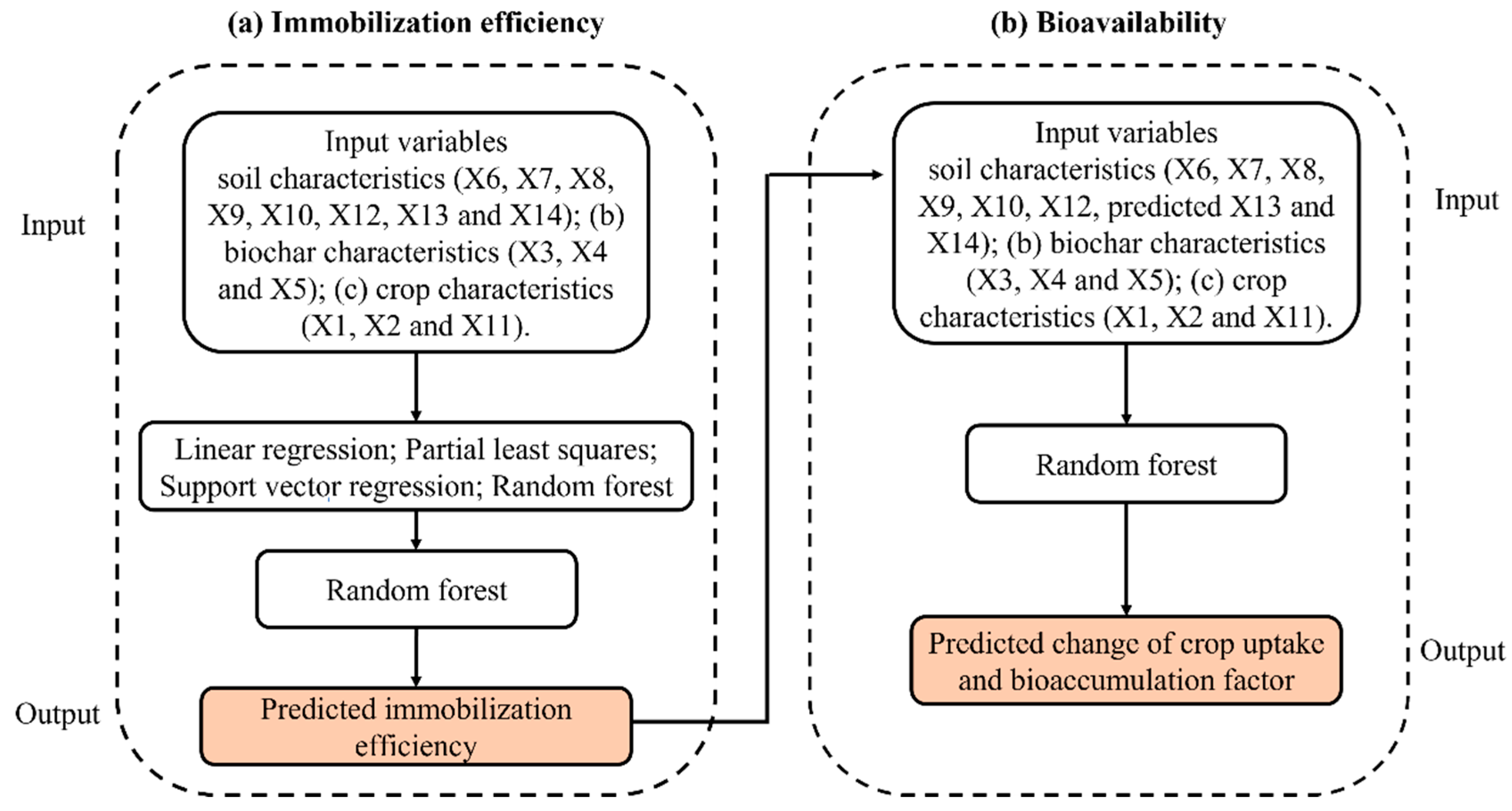
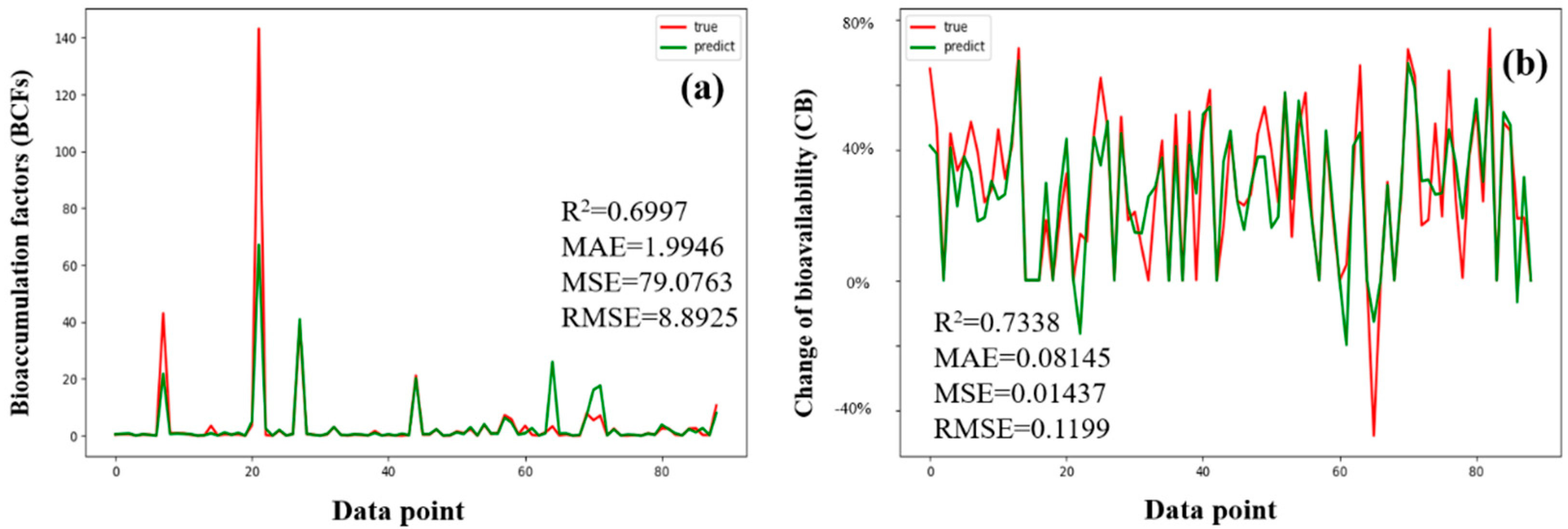
| Parameters | LR | PLS | RF | SVR |
|---|---|---|---|---|
| R2 | 0.2785 | 0.3007 | 0.5924 | 0.2421 |
| MAE | 0.2605 | 0.2587 | 0.1556 | 0.2366 |
| MSE | 0.1054 | 0.1022 | 0.0596 | 0.0966 |
| RMSE | 0.3247 | 0.3197 | 0.2441 | 0.3109 |
Disclaimer/Publisher’s Note: The statements, opinions and data contained in all publications are solely those of the individual author(s) and contributor(s) and not of MDPI and/or the editor(s). MDPI and/or the editor(s) disclaim responsibility for any injury to people or property resulting from any ideas, methods, instructions or products referred to in the content. |
© 2024 by the authors. Licensee MDPI, Basel, Switzerland. This article is an open access article distributed under the terms and conditions of the Creative Commons Attribution (CC BY) license (https://creativecommons.org/licenses/by/4.0/).
Share and Cite
Li, X.; Chen, B.; Chen, W.; Yin, Y.; Huang, L.; Wei, L.; Awad, M.; Liu, Z. Predictive Machine Learning Model to Assess the Adsorption Efficiency of Biochar-Heavy Metals for Effective Remediation of Soil–Plant Environment. Toxics 2024, 12, 575. https://doi.org/10.3390/toxics12080575
Li X, Chen B, Chen W, Yin Y, Huang L, Wei L, Awad M, Liu Z. Predictive Machine Learning Model to Assess the Adsorption Efficiency of Biochar-Heavy Metals for Effective Remediation of Soil–Plant Environment. Toxics. 2024; 12(8):575. https://doi.org/10.3390/toxics12080575
Chicago/Turabian StyleLi, Xiang, Bing Chen, Weisheng Chen, Yilong Yin, Lianxi Huang, Lan Wei, Mahrous Awad, and Zhongzhen Liu. 2024. "Predictive Machine Learning Model to Assess the Adsorption Efficiency of Biochar-Heavy Metals for Effective Remediation of Soil–Plant Environment" Toxics 12, no. 8: 575. https://doi.org/10.3390/toxics12080575
APA StyleLi, X., Chen, B., Chen, W., Yin, Y., Huang, L., Wei, L., Awad, M., & Liu, Z. (2024). Predictive Machine Learning Model to Assess the Adsorption Efficiency of Biochar-Heavy Metals for Effective Remediation of Soil–Plant Environment. Toxics, 12(8), 575. https://doi.org/10.3390/toxics12080575








